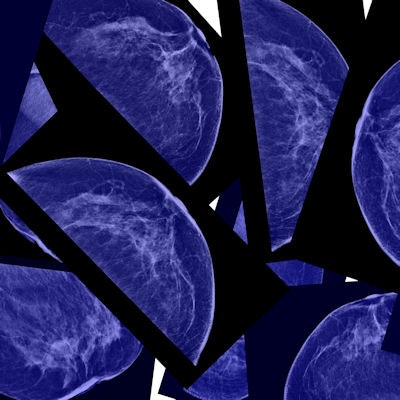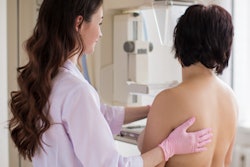
Adding digital breast tomosynthesis (DBT) to digital mammography improves breast cancer screening in women younger than 50, decreasing recalls and finding more cancers in those who have dense tissue, according to a study published online April 9 in the American Journal of Roentgenology.
The study findings address the ongoing debate about whether screening mammography's benefits outweigh its potential harms in younger women -- and offer support for its use in this population, especially because breast cancer among younger women is often invasive, according to co-authors Dr. Stephen Rose and Dr. Julie Shisler, both of Solis Mammography in Addison, TX.
"Breast cancer diagnosed in [women younger than 50] is more likely to be invasive and more aggressive; these patients also have the most years lost when death occurs due to breast cancer," they wrote. "[Our] study, which compared screening performance metrics for digital mammography to digital mammography with tomosynthesis in women younger than 50 years old, helps to provide validation of the added value of tomosynthesis to mammography screening in community-based radiology practice."
Hotly debated
The benefits of screening women between the ages of 40 and 49 have been hotly debated in recent years. Currently, the U.S. Preventive Services Task Force recommends biennial breast cancer screening beginning at age 50; it also states that evidence regarding tomosynthesis is insufficient, and that it cannot determine the balance of the technology's benefits and harms.
 Dr. Stephen Rose from Solis Mammography.
Dr. Stephen Rose from Solis Mammography.The American Cancer Society (ACS) recommends that women begin annual screening at 45, although women between 40 and 44 should have the opportunity to begin screening if they wish. Regarding tomosynthesis specifically, the ACS suggests that it may help improve the performance of mammography. The American College of Obstetricians and Gynecologists (ACOG), the American College of Radiology (ACR), and the Society of Breast Imaging (SBI) all recommend annual screening mammography beginning at age 40 and suggest that DBT should be incorporated as appropriate into a woman's screening protocol.
Rose and Shisler sought to investigate if adding DBT to digital mammography improves screening performance outcomes for younger women. For the study, they included 59,921 women in this age group who underwent screening mammography between January and December 2015 at 31 sites that are part of a community-based screening network across four states (Arizona, North Carolina, Ohio, and Texas). Of the total study cohort, 41,542 women underwent digital mammography exams and 18,379 had tomosynthesis exams; they were offered DBT regardless of breast density or insurance coverage if it was available. All of the network sites had combined digital mammography and tomosynthesis for all or part of the study period. The study did not include synthetic 2D exams.
The researchers compared recall, biopsy, and cancer detection rates, and they estimated these same measures using mixed regression models, taking screening modality, age, and breast density into account.
With a few exceptions (recall rate among women with dense tissue and cancer detection and biopsy rates among all women younger than 50), there were statistically significant, positive changes in most performance measures when DBT was added to digital mammography.
| Model regression screening metric measures for women under 50 (per 1,000 exams) | ||||||
| Screening measure | Digital mammo | Digital mammo + DBT | p-value | Digital mammo | Digital mammo + DBT | p-value |
| All women < 50 years | Women < 50 with dense tissue | |||||
| Recall rate | 117 | 108 | 0.003 | 135 | 132 | 0.44 |
| Biopsy rate | 13.5 | 16.6 | 0.003 | 16 | 20.5 | 0.004 |
| Cancer detection rate | 1.9 | 2.7 | 0.06 | 2.1 | 3.5 | 0.03 |
| PPV - recall (%) | 1.6 | 2.3 | 0.04 | 1.6 | 2.5 | 0.04 |
| PPV - biopsy (%) | 13.8 | 16.1 | 0.55 | 13.4 | 17.2 | 0.29 |
The combination of tomosynthesis and digital mammography also found more invasive cancers (1.8 per 1,000, compared with 1.2 per 1,000 for digital mammography alone) and smaller cancers (an average of 14 mm, compared with 17 mm for digital mammography alone).
Benefits vs. harms
The debate about when to begin screening for breast cancer and whether women younger than 50 should be screening has concentrated on the lower incidence of cancer in this population and the potential harms of false positives and unnecessary biopsies, the researchers wrote. But mammography's improved performance with the addition of tomosynthesis mitigates these harms, they noted.
"Recall rates decreased by nine per 1,000 screenings, which may imply fewer false-positive screening examinations even though the cancer detection rate increased," Rose and Shisler wrote.
The study supports the use of digital mammography with DBT among younger women in a community-based setting, they concluded.
"[Our] results address the benefits of adding tomosynthesis for screening women younger than 50 years old and argue strongly for using tomosynthesis to screen women in this age group," they wrote.




















